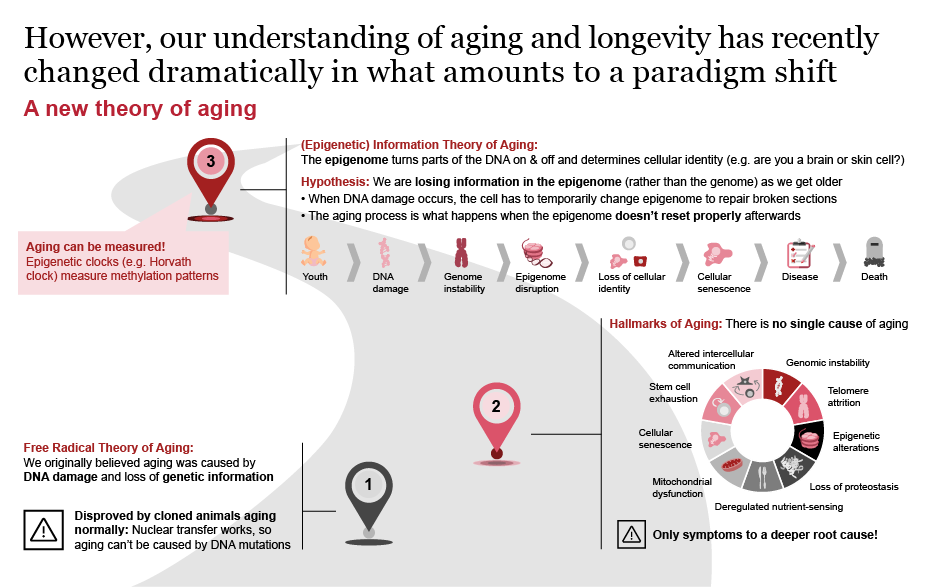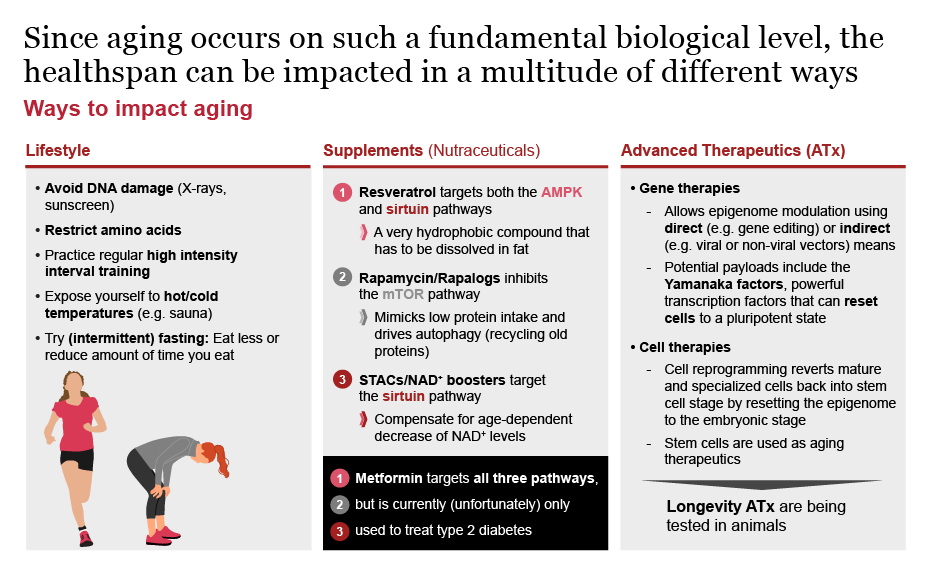{{item.title}}
{{item.text}}

{{item.title}}
{{item.text}}
Humans have always dreamed of eternal life, or at least a longer one. In this sense, a global market for treatments and therapies that can slow or even reverse the aging process has always existed. Yet it is only recently that scientists have finally identified the factors which cause us to age, enabling pharma and life sciences (PLS) companies to begin research and development on longevity products with long-term market potential.
We believe that longevity represents a significant emerging opportunity for PLS investors and businesses that keep pace with the most potentially valuable research fields in a rapidly evolving market.
Aging is seen as the root cause of many individual chronic diseases, which means the market potential of longevity therapeutics depends to some extent on what is included in this category. Most estimates of the global market value of longevity therapeutics only focus on the existing market; for example, the Allied Market Research group estimates that the total value of longevity and anti-senescence therapies was $25.1bn in 2020, and will reach $44.2bn by 2030 at a compound annual growth rate (CAGR) of 6.1 percent (see Exhibit 1).i
However, such estimates do not take into account the potential for longevity therapeutics to replace conventional therapeutics in healthcare. Taking this potential into account, the UK-based biotech company First Technology Ltd estimated in 2021 that the combined annual market value of diseases such as Type 2 diabetes that can be treated with senotherapeutics, was more than $127 bn.ii Senotherapeutics is a prominent branch of longevity therapeutics which targets cellular senescence.
Exhibit 1
i Sajeev, S. C., & Sumant, O. (2022). Longevity and Anti-senescence Therapy Market by Therapy (Senolytic Drug Therapy, Gene Therapy, Immunotherapy), by Application (Cancer, Others), by End user (Hospital, Medical Service Institution): Global Opportunity Analysis and Industry Forecast, 2020-30. Allied Market Research
ii https://longevity.technology/news/targeting-cellular-senescence-is-a-potential-127b-market/
The wide differences in estimated market sizes and definitions reflect how the longevity sector is still emerging. Most pharma companies are focused on treating the symptoms of aging, by developing therapeutics for age-related diseases such as cardiovascular diseases, cancer, or Type 2 diabetes. However, a diverse range of academic scientists, startups and biotech companies are going one step further and focusing on the root causes. If more healthcare players shift their focus as well, including key stakeholders such as insurers, regulators and providers, it could dramatically alter the market’s structure, growth and accessibility.
At present, the few pharma companies that have begun investing resources in the causes of aging are still at an early stage of R&D and have not gone further than limited collaborations on basic longevity research. One prominent example is AbbVie and Calico Life Sciences’ R&D partnership since 2014 on new therapies for patients with age-related diseases. Another is AstraZeneca’s data analytics joint venture since 2016 with Human Longevity Inc. to sequence and analyze patient samples from AZ’s clinical trials.
The lack of significant investment by the pharma sector overall is partly due to the fact that scientific advances in longevity research are relatively recent and potentially disruptive, thereby creating market uncertainty. We expect R&D in longevity therapeutics will be greatly accelerated over the five-to-ten years if it is recognized as a strategic priority by pharma companies.
A second accelerator would be regulatory approval for anti-aging longevity products. Unfortunately, aging is not at present recognized as a disease by any healthcare market regulator worldwide. This is despite one estimate by the Harvard University researcher David A. Sinclair (which is not universally accepted) that aging kills around 90 percent of the global population. iii Regulatory recognition would help unlock public funding and accelerate basic research, which in turn would facilitate the development and commercialization of safe and effective longevity therapeutics.
Regulatory recognition would also involve addressing the fundamental ethical issue of who would have access to such therapies – in plain terms, whether only the richest individuals will be able to afford a longer life, or whether everyone will benefit. Achieving a global regulatory consensus on this question will have a crucial bearing on the eventual size and structure of the longevity market.
iii Sinclair, D. A., & LaPlante, M. D.. Lifespan: Why We Age—And Why We Don't Have TTo. Atria books (2019)
The challenge for regulators, as for investors, is the sheer speed of scientific advances in longevity research over the past decade. In 2013 a ground-breaking article by Carlos López-Otín and four other scientists defined what they called the nine “hallmarks of aging” (see Exhibit 2). iv
Exhibit 2
Source: López-Otín, Blasco, Partridge, Serrano, & Kroemer, “The Hallmarks of Aging”, Cell, Vol 153, 6, 2013
These hallmarks are universally considered to be accurate indicators of aging, but lack an apparent root cause that explains why they are observable in the first place. More recently, research by Sinclair suggests there may be an answer. Sinclair identifies one root cause of aging centered on the epigenome - the collection of chemical modifications to a person’s DNA that determine which parts are switched on or off.v According to Sinclair, as we age we lose information in the epigenome, which causes cells to start behaving in ways that they should not. In his 2019 book Lifespan: Why We Age—and Why We Don't Have To, Sinclair contends that this process can be treated. Sinclair has also set out the scientific evidence for his Epigenetic Information Theory of Aging in peer-reviewed academic journals.vi
Sinclair’s theory has stirred a lot of debate in the field. Certain critical questions remain as yet unanswered, and the body of evidence is still emerging. Nonetheless, his work is praised by many medical and scientific professionals as representing a major shift in how aging can and perhaps should be viewed.
One key point is that the goal of any longevity therapeutic is to extend a person’s healthspan as opposed to their total lifespan – in other words, the period during which they are generally in good health. The healthspan can already be extended by lifestyle choices that anyone can make. These include using sunscreen protection against harmful UV rays, as well as supplements that target longevity pathways such as the sirtuin pathway. Importantly though, the healthspan could potentially also be extended by advanced therapeutics (ATx) such as cell and gene therapies (see Exhibit 3).
Exhibit 3: Three ways to expand a person’s healthspan
Source: Sinclair & LaPlante, 2019
The scientific evidence for the efficacy of longevity supplements such as nicotinamide mononucleotide (NMN), rapamycin and metformin is still emerging. Currently, therefore, advanced therapeutics (ATx) are the only external means with the potential to truly halt and even reverse aging.
For example, one potential future application of ATx involves the administration of Yamanaka transcription factors which have been shown to reverse cellular age, and could eventually be used to reset an entire body to a more youthful state. A set of Yamanaka factors could be injected using a viral vector and activated at regular intervals such as every 10-15 years during which the treated individual would undergo a fundamental rejuvenation process as their epigenome resets. At the end of each activation period, the person would be biologically, physically and mentally decades younger, yet retain all of their knowledge and memories (see Exhibit 4).
Barring any deadly infection or accident, this might in theory allow the individual to live for as long as they wished, according to Sinclair (Sinclair & LaPlante, 2019). Currently, Sinclair says he is optimistic that advances in our understanding of how to retard the aging process mean that “somebody who might make it to 150 has already been born”.vii
Exhibit 4: Reversing the aging process – how Yamanaka factors work
Source: Strategy &, based on Sinclair & Plante, 2019
As mentioned above, arguably the most disruptive and revolutionary impact of longevity therapeutics could be its potential to replace conventional therapies, due to the nature of aging itself. For example, in a 2017 paper published by the U.S. journal Frontiers in Public Health, Efraim Jaul and Jeremy Barron suggested that aging was the root cause of a multitude of seemingly unrelated diseases, including cardio- and cerebrovascular disease, cancer, Type 2 diabetes, dementia, osteoarthritis and osteoporosis.viii From the same perspective, an editorial in The Lancet Healthy Longevity journal argued that by targeting aging one could strike directly at the source of all these diseases before they were fully manifested.ix
iv López-Otín, C., Blasco, M. A., Partridge, L., Serrano, M., & Kroemer, G. (2013). The hallmarks of aging. Cell, 1194-1217.
v Bernstein, B. E., Meissner, A., & Lander, E. S. (2007). The mammalian epigenome. Cell, 669-681.
vi See, for example, Yang, J., Hayano, M., Griffin, P.T., Pfenning, A.R., Rajman, L.A., Sinclair, D.A. (2023). Loss of epigenetic information as a cause of mammalian aging. Cell, 305-326.
vii Powell, A. (2023). Has first person to live to be 150 been born? Interview with David Sinclair and Jae-Hyun Yang. The Harvard Gazette, Jan 30, 2023, https://news.harvard.edu/gazette/story/2023/01/has-first-person-to-live-to-be-150-been-born/
viii Jaul, E., & Barron, J. (2017). Age-related diseases and clinical and public health implications for the 85 years old and over population. Frontiers in public health, 335.
ix Editorial. (2022). Is ageing a disease? The Lancet Healthy Longevity, E448.
Viewed as a field – however it is defined – longevity is undergoing a period of rapid, disruptive upheaval, as medical science begins to target aging itself as the root cause of a range of age-related diseases, with the potential to dramatically increase people’s life expectancy. In this rapidly shifting landscape, it is a complex task to navigate emerging science to unlock the most long-term value for PLS companies.
Yet at this stage in the longevity market’s evolution, there is no question about where PLS companies and investors should be focusing their attention. We recommend that they should seek out ATx as the modality with the most promising scientific and commercial potential. It is here that the market for longevity is finally beginning to emerge.
Dr. Malte Kremer, former Partner, Edward Hamer, former Director, and Alexander Grimm, former Senior Associate at Strategy& Germany, as well as Sebastian Kwisda, former Manager at Strategy& Switzerland, also contributed to this article.




